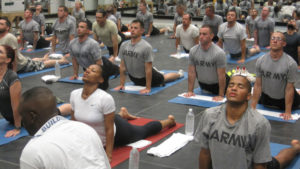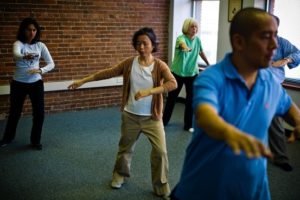Produce Lasting Improvement in Post-Traumatic Stress Disorder (PTSD) with Yoga
By John M. de Castro, Ph.D.
“Knowledge of yoga can help relieve us, direct us and give clarity of mind. It is the ultimate self-help. The first step in yoga practice is to link the mind and body through the breath, bringing awareness to what is happening in the moment. Intense feelings and thoughts can be experienced and reduced in intensity as the mind becomes more still and calm and the body allows the sensations to pass. With repeated practice and guidance, a yoga practice can bring long term relief and a fresh perspective on life for PTSD sufferers.” – Art of Living
Experiencing trauma is quite common. It has been estimated that 60% of men and 50% of women will experience a significant traumatic event during their lifetime. But, only a fraction will develop Post-Traumatic Stress Disorder (PTSD). But this still results in a frightening number of people with 7%-8% of the population developing PTSD at some point in their life. For military personnel, it’s much more likely for PTSD to develop with about 11%-20% of those who have served in a war zone developing PTSD.
PTSD involves a number of troubling symptoms including reliving the event with the same fear and horror in nightmares or with a flashback. PTSD sufferers avoid situations that remind them of the event this may include crowds, driving, movies, etc. and may avoid seeking help because it keeps them from having to think or talk about the event. They often experience negative changes in beliefs and feelings including difficulty experiencing positive or loving feelings toward other people, avoiding relationships, memory difficulties, or see the world as dangerous and no one can be trusted. Sufferers may feel hyperarousal, feeling keyed up and jittery, or always alert and on the lookout for danger. They may experience sudden anger or irritability, may have a hard time sleeping or concentrating, may be startled by a loud noise or surprise.
Obviously, these are troubling symptoms that need to be addressed. There are a number of therapies that have been developed to treat PTSD. One of which, mindfulness training has been found to be particularly effective. In today’s Research News article “Yoga for Adult Women with Chronic PTSD: A Long-Term Follow-Up Study.” (See summary below), Rhodes and colleagues examine the ability of yoga practice to treat the symptoms of Post-Traumatic Stress Disorder (PTSD) in women who had persistent symptoms that didn’t respond to treatment. They demonstrated in a prior study that yoga practice produces significant reductions in PTSD symptom severity and PTSD diagnosis and decreases in engagement in negative tension reduction activities (e.g., self-injury), and greater reductions in dissociative and depressive symptoms. In the present study, they performed a long-term follow-up by measuring the participants 1.5 years later for PTSD symptoms, dissociative experiences, depression, engagement in negative tension reduction activities (e.g., self-injury), and stressful life events.
They found that 1.5 years after the completion of the study the differences between the yoga and control groups were no longer present. They found that 88% of the women in the yoga practice group continued to practice. After completion of the control condition, the participants were offered training in yoga and 44% chose it. All of these women continued practice later. They found, however, that the higher the frequency of yoga practice at follow-up the lower the levels of depression and PTSD symptom severity and the lower the likelihood of a PTSD diagnosis.
These are encouraging results that suggest that yoga practice is an effective treatment for PTSD for women and if the practice continues, the benefits continue for at least a year and a half. But, if the practice is discontinued, the benefits will regress. These results are particularly encouraging as these women were the most difficult and intransigent cases that didn’t respond to other treatments. Yet, they responded to yoga practice. These results suggest that yoga practice should be studied to treat PTSD in men. They further suggest that yoga practice should be incorporated into the treatment package to treat PTSD in women.
So, produce lasting improvement in post traumatic stress disorder (PTSD) in women with yoga.
“The goal of treatment should be to resolve this disconnect. “If we can help our patients tolerate their own bodily sensations, they’ll be able to process the trauma themselves. . . patients, particularly those suffering from treatment-resistant PTSD, yoga has proved an especially good way to do this.” – Jeneen Interlandi
CMCS – Center for Mindfulness and Contemplative Studies
This and other Contemplative Studies posts are also available on Google+ https://plus.google.com/106784388191201299496/posts and on Twitter @MindfulResearch
Study Summary
Rhodes, A., Spinazzola, J., & van der Kolk, B. (2016). Yoga for Adult Women with Chronic PTSD: A Long-Term Follow-Up Study. Journal Of Alternative & Complementary Medicine, 22(3), 189-196. doi:10.1089/acm.2014.0407
Abstract:
Introduction: Yoga-the integrative practice of physical postures and movement, breath exercises, and mindfulness-may serve as a useful adjunctive component of trauma-focused treatment to build skills in tolerating and modulating physiologic and affective states that have become dysregulated by trauma exposure. A previous randomized controlled study was carried out among 60 women with chronic, treatment-resistant post-traumatic stress disorder (PTSD) and associated mental health problems stemming from prolonged or multiple trauma exposures. After 10 sessions of yoga, participants exhibited statistically significant decreases in PTSD symptom severity and greater likelihood of loss of PTSD diagnosis, significant decreases in engagement in negative tension reduction activities (e.g., self-injury), and greater reductions in dissociative and depressive symptoms when compared with the control (a seminar in women’s health). The current study is a long-term follow-up assessment of participants who completed this randomized controlled trial. Methods: Participants from the randomized controlled trial were invited to participate in long-term follow-up assessments approximately 1.5 years after study completion to assess whether the initial intervention and/or yoga practice after treatment was associated with additional changes. Forty-nine women completed the long-term follow-up interviews. Hierarchical regression analysis was used to examine whether treatment group status in the original study and frequency of yoga practice after the study predicted greater changes in symptoms and PTSD diagnosis. Results: Group assignment in the original randomized study was not a significant predictor of longer-term outcomes. However, frequency of continuing yoga practice significantly predicted greater decreases in PTSD symptom severity and depression symptom severity, as well as a greater likelihood of a loss of PTSD diagnosis. Conclusions: Yoga appears to be a useful treatment modality; the greatest long-term benefits are derived from more frequent yoga practice.








